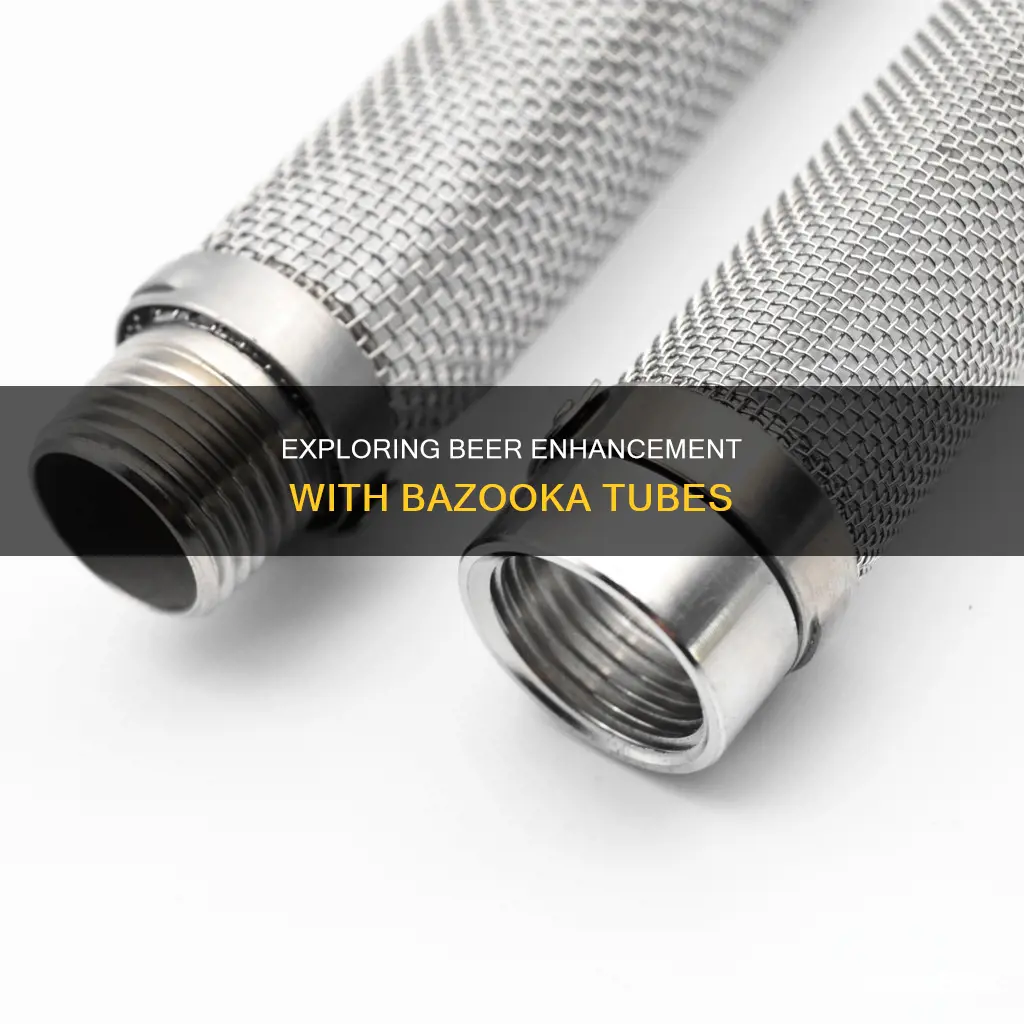
Bazooka tubes are a cheap, reliable, and easy-to-use tool for homebrewers. They are used to filter out hops and grain remnants from the beer wort, resulting in clearer beer. While they can get clogged, especially with pellet hops, they are still a popular choice for brewers as they are sturdy and allow for higher flow rates. Some brewers opt for alternatives such as hop socks, paint strainers, or copper manifolds, but bazooka tubes remain a common tool for those looking for an affordable and effective way to improve their homebrewing process.
| Characteristics | Values |
|---|---|
| Cost | Cheap |
| Reliability | Reliable |
| Material | Stainless steel |
| Pros | Cheap, reliable, and inexpensive |
| Cons | Clogs easily, coarse mesh |
| Use case | Straining out leaf hops in the boil kettle |
What You'll Learn

Advantages of bazooka tubes
The bazooka tube is a rugged tube of stainless-steel screen used to filter trub and hops from your wort while transferring from your kettle to your fermenter. Here are some advantages of using bazooka tubes:
- Cost-effective: Bazooka tubes are a cheap and reliable option for home brewers. They are inexpensive and can be easily purchased or made at home with some basic materials.
- Durability: The bazooka tube is made of stainless steel, which makes it a heavier and more durable option compared to other filtering methods. It can withstand the weight of the grains above it without being affected.
- Efficiency: Bazooka tubes are effective in filtering out grain shells and hop leaves, resulting in clearer beer. They allow for higher flow rates, making the transfer process faster and more efficient.
- Flexibility: Bazooka tubes can be used in both mash tuns and kettle filters, offering flexibility in their application. They are also suitable for both batch sparging and fly sparging, accommodating different brewing techniques.
- Ease of Use: Bazooka tubes are easy to install and use. They can be attached to the kettle spigot, directing the flow of liquid during the transfer process.
- Simplicity: For those who enjoy the process of building and creating their own equipment, a bazooka tube is a simple and straightforward option. It does not require welding or complex assembly, making it accessible to those with basic DIY skills.
While bazooka tubes have their advantages, it is important to note that they have some limitations as well. They have a coarse mesh that can allow smaller particulates to pass through, and they can also clog fairly easily, especially with pellet hops. However, with proper maintenance and the use of additional straining methods, these issues can be mitigated.
The Magic of Beer Widgets: How Do They Work?
You may want to see also

Disadvantages of bazooka tubes
Bazooka tubes are a cheap and reliable option for home brewers. However, they do have some disadvantages. One issue is that the bazooka mesh is quite coarse, allowing smaller particulates to escape into the fermenter. This can result in a messier brewing process and a less clear beer. Additionally, the coarse mesh is prone to clogging, which can slow down the brewing process and require manual intervention to scrape off the buildup.
Another disadvantage of bazooka tubes is that they may need to be cut or crimped to fit the specific cooler or setup being used. This can be frustrating, especially for those who are looking for an easy and convenient solution.
Some brewers also find that the bazooka tube can be bent or crushed during the stirring process, which can affect its effectiveness and require replacement.
While bazooka tubes are a simple and cost-effective option, they may not provide the same level of precision and efficiency as more specialised equipment, such as a copper manifold or a false bottom. These alternatives can offer better flow rates and extraction rates, resulting in a more efficient brewing process.
Overall, while bazooka tubes can be a good option for home brewers, they do have some drawbacks that should be considered before adoption.
The Science Behind Beer Koozies: Do They Really Work?
You may want to see also

Alternatives to bazooka tubes
While bazooka tubes are cheap, reliable, and easy to use, there are several alternatives that can be used to strain the wort and achieve clearer beer. Here are some alternatives to bazooka tubes:
- Copper Manifold: Building a copper manifold is a great option for those who enjoy DIY projects and want to feel a sense of accomplishment. It requires some basic welding or soldering skills, but it's not too complicated and can be made with easily accessible materials. The efficiency is similar to that of a bazooka tube, but the copper manifold offers a more satisfying experience for those who want to feel like they're "making" something from scratch.
- Stainless Steel (SS) Braid: An SS braid is another option for straining the wort. It is important to ensure that the braid is made of actual stainless steel and not just plastic that looks like SS. The SS braid can be reinforced by snaking a perforated piece of plastic tubing through it to prevent crushing. This method provides better filtering than a manifold but requires more care to avoid damage.
- False Bottom: A false bottom is a more expensive option but is highly effective in straining the wort. It is often recommended for rectangular coolers or mash tuns where a manifold or braid may not be as efficient. A false bottom allows for efficient straining and can be cleaned easily.
- Hop Sock or Paint Strainer: For those unexpected brew days when you don't have a bazooka tube or other equipment, a hop sock or paint strainer can be a lifesaver. These are thin, finely meshed bags that can be wrapped around the transfer tube to catch even the finest particles. They are temperature-resilient and can be found at most hardware stores.
- Hop Spider or Hop Bags: If you're dealing with hoppy beers and want to avoid clogging, a hop spider or hop bags can be a great solution. Hop spiders are containers that hold all the hop crud, making it easier to dump everything out when you're done. Hop bags, made of muslin or nylon, can be used to contain whole hops or pellets, respectively, and prevent them from floating around and clogging your equipment.
Antibiotics and Beer: A Safe Mix?
You may want to see also

Using bazooka tubes with other materials
Bazooka tubes are used in the process of homebrewing to help strain the wort and keep it clear of debris. While they are typically made of stainless steel, some people have experimented with making their own bazooka tubes out of other materials, such as fibre material braid, PVC, or even deodorant gas and PVC plumbing fittings.
One person on a homebrewing forum shared their experience of using a bazooka tube made with a fibre material braid, which required adjustments after each use due to holes wearing into it. They eventually switched to a stainless steel washer hose, which they found to be easier to use and more durable.
Another homebrewer considered using a bazooka tube in their kettle but was concerned about the limited space and the potential for the tube to interfere with their immersion chiller. They were also interested in finding a way to filter out hops and cold break without spending a lot of money or taking up too much space. Some forum members suggested using a pickup tube and a bazooka T, with the bazooka T positioned close to the wall of the kettle to keep it out of the way.
In addition to stainless steel and alternative DIY materials, bazooka tubes can also be made of other metals such as copper. One homebrewer shared their preference for building a copper manifold instead of using a bazooka tube, as it gave them a greater sense of accomplishment and allowed them to optimise fluid flow and heat transfer. However, they acknowledged that both methods would result in similar efficiency.
Overall, while bazooka tubes are typically made of stainless steel, some people have experimented with using other materials, such as copper, PVC, or even deodorant gas and plumbing fittings. While these alternative materials may be cheaper and easier to work with, they may not always provide the same level of durability or efficiency as stainless steel bazooka tubes.
Morning Beer: Should You Drink Before Work?
You may want to see also

Cleaning and maintaining bazooka tubes
Cleaning and maintaining your bazooka tubes is an important step in the homebrewing process. Here are some detailed tips to help you keep your equipment in top condition:
Cleaning the Tube:
- After each use, take your bazooka tube outside and spray off any remaining mud or residue.
- Rinse the inside of the tube by attaching a sprayer to the back and spraying until the water runs clear.
- Fill the tube with water by spraying into the opening, then manually turn the crank to bring the plunger up, cleaning the inside of the tube.
- Finish by spraying the entire tube, including the inside, with a lubricant like WD-40.
- Soaking the tube overnight in a bucket of water can help loosen any stubborn residue.
Maintaining the Tube:
- Cut a sponge to fit inside the tube to prevent mud from drying during use and to provide a cushion for the plunger.
- When stopping for extended periods, place the nose of the tube in a bucket of water to prevent the mud from drying.
- Regularly inspect and clean the cable and nozzle, ensuring no residue builds up.
- Consider using a cylindrical brush with a long handle to clean and store in the open end of the tube.
- If taping ceiling flats, always set the bazooka nose down in a bucket of water when stopping to prevent mud from drying.
By following these steps, you can keep your bazooka tubes clean and well-maintained, ensuring efficient and effective homebrewing.
Beer and Bowel Movements: The Laxative Effect
You may want to see also
Frequently asked questions
A bazooka tube is a type of filter used in homebrewing to separate hops and grain from the beer.
Bazooka tubes are cheap, reliable, and inexpensive. They are also easy to install and clean.
Bazooka tubes can get clogged with hops and other debris, which can slow down the brewing process. The mesh is also coarse, allowing smaller particles to pass through.







